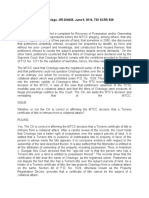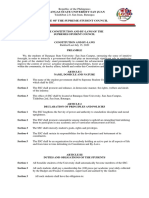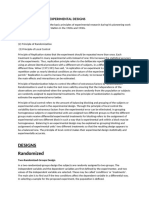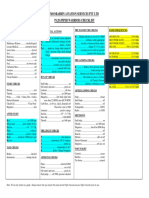Causal Research
Causal Research
Uploaded by
nirajmishraCopyright:
Available Formats
Causal Research
Causal Research
Uploaded by
nirajmishraCopyright
Available Formats
Share this document
Did you find this document useful?
Is this content inappropriate?
Copyright:
Available Formats
Causal Research
Causal Research
Uploaded by
nirajmishraCopyright:
Available Formats
CAUSAL RESEARCH
The foremost goal of causal research (also referred to as experimental research) is to recognise and obtain evidence with regard to cause-and-effect relationships between variables in the problem model. Exploratory and descriptive research usually paves the way for cause-and-effect relationship studies. Whilst descriptive research is able to examine associations between variables, causal research has the potential to illustrate that a change in one variable causes some predictable change in another variable. In the latter research type, researchers typically have an anticipation about the relationship to be explained and must thus be quite knowledgeable about the subject in order to attempt to explain why things happen. Roughly speaking, causal research is suitable to be used in any of the following scenarios: to realise which variables are the cause (independent variables) and which variables are the effect (dependent variables) of a phenomenon; and to verify the nature of the relationship between the causal variables and the effect to be predicted. Causal research is characterized by a structured design and a considerable amount of planning. This design sees how various independent variables are manipulated in order to check how a dependent variable is affected within a relatively controlled environment something which other research approaches are not capable of doing. There are, however, disadvantages of causal research. Some of the most common issues include it being expensive, having administration problems, not always being a good market representation and that competitors are able to audit the prevailing results. Uses of Causal Research To understand which variables are the cause (independent variables) and which variables are the effect (dependent variables) of a phenomenon To determine the nature of the relationship between the causal variables and the effect to be predicted
Independent & Dependent Variables
The manipulated variable is called the INDEPENDENT VARIABLE. This is the presumed "cause." The variable that is expected to change as a result of the manipulation of the independent variable is called the DEPENDENT VARIABLE. This is the presumed "effect."
Try the following exercise to see if you can identify the independent and dependent variables. A researcher wanted to study the effects of sleep deprivation on physical coordination. The researcher selected 25 year-old male college students and deprived some of the subjects to either 24, 36, or 45 hours of sleep. In the present study the independent variable was: a) the length of time the subjects were deprived of sleep. b) the age of the subjects. c) the gender of the subjects. d) the physical coordination skills of the subjects. In the present study the dependent variable was: a) the length of time the subjects were deprived of sleep. b) the age of the subjects. c) the gender of the subjects. d) the physical coordination skills of the subjects. Control & Experimental Groups In an experiment, researchers are typically concerned about the performance of subjects in the experimental group. If a researcher wants to know if a new drug helps improve memory, the researcher is most interested in the how people who are given the drug perform on the memory test. However, in order to conclude that the drug "improves" memory, people who take it must perform better than those who do not take the drug. The CONTROL GROUP serves as the BASELINE performance. The group given the drug serves as the EXPERIMENTAL GROUP. Extraneous Variables In order to isolate the effect of the independent variable on the dependent variable, researchers must rule out alternative explanations. In other words, only the independent variable can be allowed to vary. The term EXTRANEOUS VARIABLE is used to refer to any other factor that might affect the dependent variable.
1. Evidence to Support Causation Concomitant variation If X is supposed to cause Y, then the two variables must move together. If one variable changes, we should observe a resulting change in the other. Time order of occurrence If X is supposed to cause Y, then changes in X must precede changes in Y.
Elimination of other possible causes If X causes Y, no other factor could have reasonably caused the change in Y at that moment. Must hold all other variables constant. 2. Experiments are the best way to satisfy elements of causation. 3. May be Field Experiment or Laboratory Experiment 4. Tradeoff between realism versus control 5. Examples of experimentation in marketing Market test (test marketing) Advertising response (recall, affect, attitude toward ad elements) Promotional design (consumer response to promotional deals, incentives, tie-ins Store layout and design Product positioning Color tracking and package design Basic principles of Experimental Designs: Prof. R. A. Fisher has enumerated three principles of experimental designs: 1. The principle of replication 2. The principle of randomization and 3. Principle of local control 1. The principle of replication: According to the principle of replication, the experiment should be repeated more than once. Thus, each treatment is applied in many experimental units instead of one. By doing so the statistical accuracy of the experiments is increased. For example if we are supposed to examine the effect of two varieties of rice. For this purpose we may divide the field into two parts and grow one veriety in one part and another variety in the other part. We can then compare the yield of the two parts and draw conclusion on that basis. But if we are going to apply principle of replication to this experiment, then we first divide the field into several parts, grow one variety on half of these parts and another in the other half. We the collect data of yield of the two varieties and draw conclusions comparing the same. The result so obtained will be more reliable than the result obtained without application of replication. The entire experiment can be repeated several times for getting better results. 2. The principle of randomization The principle of randomization provides protection, when we conduct an experiment, against the effects of extraneous factors by randomization. This principle indicates that we should design or plan the experiment in such a way that the variations caused by extraneous factors can all be combined under the general heading of chance For Example- if we grow one variety of rice in first half and another variety in other half, then it is possible that the soil fertility may be different in the first half in comparison to the second half. If so our results will not be realistic. In such a situation we may assign the variety of rice to be grown in different parts of the field on the basis of some random techniques. 3. The principle of local control
Under it the extraneous factor, the known source of variability, is made to vary deliberately over as wide a range as necessary and this needs to be done in such a way that the variability it causes can be measured and hence eliminated from the experimental error. According to principle of local control we first divide the field into several homogenous parts, known as blocks, and then each such block is divided into parts equal to number of treatment. Then the treatments are randomly assigned to these parts of a block. Dividing the field into several homogeneous parts is known as blocking. In general, blocks are the levels at which we hold an extraneous factor fixed, so that we can measure its contribution to the total variability of the data by means of a two-way analysis of variance. In brief, through the principle of local control we can eliminate the variability due to extraneous factor(s) from the experimental error. Here, Treatments: Rice Extraneous factor: Soil fertility Types of Experimental designs 1. Before-and-after without control design In such a design a single test group or area is selected and the dependent variable is measured before the introduction of the treatment. The treatment is then introduced and the dependent variable is measured again after the treatment has been introduced. The effect of the treatment will be equal to the level of the phenomenon after the treatment minus the level of the phenomenon before the treatment. The design can be represented thus:
Test area:
Level of phenomenon Before treatment (X)
Treatment introduced
Level of phenomenon after treatment (Y)
Treatment Effect = (Y)-(X)
2. After-only with control design In this design two group or areas (test area and control area) are selected and the treatment is introduced into the test area only. The dependent variable is then measured in both the areas at the same time. Treatment impact is assessed by subtracting the value of dependent variable in the control area from its value in the test area. The design can be shown as
Test area: Level of phenomenon Before treatment Treatment introduced Level of phenomenon after treatment (Y) Level of phenomenon after treatment (Z) Treatment Effect = (Y)-(Z)
Control area:
3. Before-and-after with control design In this design two areas are selected and the dependent variable is measured in both the areas for an identical time period before the treatment. The treatment is then introduced in the test area only, and the dependent variable is measured in both for an identical time period after the introduction of the treatment. The treatment effect is determined subtracting the change in the dependent variable in the control area from the change in the dependent variable in test area. The design can be shown as
Test area:
Level of phenomenon Before treatment (X) Level of phenomenon Without treatment (A) Treatment Effect = (Y-X) (Z-A)
Treatment introduced
Level of phenomenon after treatment (Y) Level of phenomenon after treatment (Z)
Control area:
You might also like
- Solution Manual For Electronic Principles 8th Edition by Malvino Chapters 1 22 PDFDocument6 pagesSolution Manual For Electronic Principles 8th Edition by Malvino Chapters 1 22 PDFWaseem Hassan18% (17)
- Chevron GROUP 12Document36 pagesChevron GROUP 12mohan raoNo ratings yet
- How To Motivate Your TeamDocument3 pagesHow To Motivate Your TeamemekaokaekwuNo ratings yet
- (ELEMENTS Conspiracy) RICKETTSDocument18 pages(ELEMENTS Conspiracy) RICKETTSThethan ArenaNo ratings yet
- Project ManagementDocument7 pagesProject ManagementSureshVuppalaNo ratings yet
- Developing Essential Project Management SkillsDocument50 pagesDeveloping Essential Project Management SkillsPrashant ManoriNo ratings yet
- Tax Declaration VsDocument2 pagesTax Declaration VsjamesNo ratings yet
- Rules On Evidence Atty SalendabDocument41 pagesRules On Evidence Atty SalendabAyla Herazade Salendab100% (1)
- Land Titles Case DoctrinesDocument2 pagesLand Titles Case DoctrineslchieSNo ratings yet
- A Review On: Criminal EvidenceDocument77 pagesA Review On: Criminal EvidenceAntonet CabtalanNo ratings yet
- Gabriel, Jr. v. Crisologo, GR 204626, June 9, 2014, 725 SCRA 528Document1 pageGabriel, Jr. v. Crisologo, GR 204626, June 9, 2014, 725 SCRA 528Gia DimayugaNo ratings yet
- Crisis Intervention Fall 2007 Powerpoint 1196291386615379 2Document12 pagesCrisis Intervention Fall 2007 Powerpoint 1196291386615379 2RemyaKiranNo ratings yet
- Effects of Declaration of NullityDocument3 pagesEffects of Declaration of NullityJacqueline PaulinoNo ratings yet
- Communication As A Tool of Management PPT Group 10Document8 pagesCommunication As A Tool of Management PPT Group 10swarnagopal dasNo ratings yet
- Motion For Resetting-DonnalouDocument3 pagesMotion For Resetting-Donnaloumarvilie sernaNo ratings yet
- A.M. No. 07-8-2-SC Rule On Children Charged With 9165Document32 pagesA.M. No. 07-8-2-SC Rule On Children Charged With 9165Dbee Dvee100% (1)
- Deed of Sale of Motor Vehicle Roy PalerDocument1 pageDeed of Sale of Motor Vehicle Roy PalerRonelio Marabante100% (1)
- Written Report Training and Developing EmployeesDocument8 pagesWritten Report Training and Developing EmployeesDerrick DumolNo ratings yet
- Batangas State University San JuanDocument6 pagesBatangas State University San JuanJimwel GutierrezNo ratings yet
- Pawb Technical Bulletin NO. 2013-05: (Caves and Cave Resources Conservation, Management and Protection)Document6 pagesPawb Technical Bulletin NO. 2013-05: (Caves and Cave Resources Conservation, Management and Protection)Billy RavenNo ratings yet
- Circumstances Affecting Criminal LiabilityDocument51 pagesCircumstances Affecting Criminal LiabilityCatherine100% (1)
- Persons and Family Relations: San Beda College of LawDocument3 pagesPersons and Family Relations: San Beda College of LawstrgrlNo ratings yet
- 03 DENR ProceduresDocument77 pages03 DENR ProceduresJanice OmadtoNo ratings yet
- PD 463Document16 pagesPD 463givemeasign24No ratings yet
- ESA - Project SPLIT - DAR Version 17 March 2020Document53 pagesESA - Project SPLIT - DAR Version 17 March 2020Venus Zcxiv AquinoNo ratings yet
- Drug CaseDocument7 pagesDrug CaseLhine Kiwalan0% (1)
- Offenders With Final Conviction Disqualified For ProbationDocument2 pagesOffenders With Final Conviction Disqualified For Probationyurets929No ratings yet
- Suyan V PeopleDocument2 pagesSuyan V PeoplepapepipupoNo ratings yet
- Pag-Ibig LetterDocument1 pagePag-Ibig Letterpetron.vmapaNo ratings yet
- DC2017DEC062 Guidelines On Forfeitable Leave DTD 21 Dec 2017Document2 pagesDC2017DEC062 Guidelines On Forfeitable Leave DTD 21 Dec 2017Mymy AlbaytarNo ratings yet
- Introduction To LawDocument2 pagesIntroduction To Lawliabraganza100% (2)
- Third Party ComplaintDocument2 pagesThird Party ComplaintKrissie GuevaraNo ratings yet
- Introduction To Training and DevelopmentDocument25 pagesIntroduction To Training and DevelopmentGeetika PuriNo ratings yet
- Consti 2 Cases On Due Process CompilationDocument33 pagesConsti 2 Cases On Due Process CompilationKara Russanne Dawang AlawasNo ratings yet
- Provisional DismissalDocument1 pageProvisional DismissalMyra CoronadoNo ratings yet
- Deped Revised Rules.2007ed.2Document131 pagesDeped Revised Rules.2007ed.2Ce JeyNo ratings yet
- BAR MATTER 1153 Estelito MendozaDocument21 pagesBAR MATTER 1153 Estelito MendozaSamiha TorrecampoNo ratings yet
- Spa DraftDocument3 pagesSpa DraftJD Buhangin100% (1)
- RA 3019 Sec 3 (F)Document3 pagesRA 3019 Sec 3 (F)David Cameron100% (2)
- Exemption DOJ 44 Template69167128 Motion To Dismiss SampleDocument13 pagesExemption DOJ 44 Template69167128 Motion To Dismiss SampleBonn PustaNo ratings yet
- Consitutional Right To Due Process As TH PDFDocument26 pagesConsitutional Right To Due Process As TH PDFMyrna L. TejadaNo ratings yet
- PAB Resolution 1 CDocument19 pagesPAB Resolution 1 CMelvinDapitanonNo ratings yet
- Updated Deped Admin RulesDocument30 pagesUpdated Deped Admin RuleskeouhNo ratings yet
- Conveyances and Illegal Transfers - DarDocument16 pagesConveyances and Illegal Transfers - DarDaryl Navaroza BasiloyNo ratings yet
- TIGLAO Impeachment Complaint PDFDocument54 pagesTIGLAO Impeachment Complaint PDFIsagani DionelaNo ratings yet
- Affidavit of Loss: Joselito F. GudioDocument1 pageAffidavit of Loss: Joselito F. GudioJinJiShinNo ratings yet
- SC Comments - Igano RXDocument8 pagesSC Comments - Igano RXGenesy TimoneraNo ratings yet
- Ban Animal Testing (Junior)Document4 pagesBan Animal Testing (Junior)Kriyaashini VijeyanNo ratings yet
- EODB - Tailored Fit - PPT - TrainingDocument27 pagesEODB - Tailored Fit - PPT - Traininggermz durato100% (1)
- Motion To Render Judgment - Teodora AstillaDocument11 pagesMotion To Render Judgment - Teodora AstillaJonathan P. OngNo ratings yet
- Sim v. NLRCDocument14 pagesSim v. NLRCjoycebaylonNo ratings yet
- Cebu Portland Cement Co. v. Municipality ofDocument5 pagesCebu Portland Cement Co. v. Municipality ofDenise LabagnaoNo ratings yet
- Overuse of Pretrial Detention in Tension With Judicial and Prison Reforms in The Dominican RepublicDocument25 pagesOveruse of Pretrial Detention in Tension With Judicial and Prison Reforms in The Dominican RepublicYunior Andrés Castillo SilverioNo ratings yet
- Affidavit of Guardianship SampleDocument1 pageAffidavit of Guardianship SampleErto JaranillaNo ratings yet
- DECLARATION Non Pendency FormDocument1 pageDECLARATION Non Pendency FormJardy Gambong Fuentes IINo ratings yet
- Media Rep Stipulation TPDocument1 pageMedia Rep Stipulation TPnimkiNo ratings yet
- Class - 6 Experimental ResearchDocument24 pagesClass - 6 Experimental Researchnitesh34No ratings yet
- Experimental Designs and Controlling EvDocument19 pagesExperimental Designs and Controlling EvSoumi DeyNo ratings yet
- Lecture Notes: Take Note! Characteristics of A Good Experimental DesignDocument5 pagesLecture Notes: Take Note! Characteristics of A Good Experimental Designmarvin jay0% (1)
- Answer 3Document6 pagesAnswer 3Manjushree RandiveNo ratings yet
- Database, Is The Combination of Some Data That Is Processed and Organized in Such A Way, ToDocument2 pagesDatabase, Is The Combination of Some Data That Is Processed and Organized in Such A Way, TonirajmishraNo ratings yet
- DBA GIE May2016 Assignment 1 (Ikea)Document5 pagesDBA GIE May2016 Assignment 1 (Ikea)nirajmishraNo ratings yet
- Lect 4 ChisqDocument22 pagesLect 4 ChisqnirajmishraNo ratings yet
- SPSS (Lab)Document11 pagesSPSS (Lab)nirajmishraNo ratings yet
- Bba101 - General Principles of ManagementDocument1 pageBba101 - General Principles of ManagementnirajmishraNo ratings yet
- Environment ApprisialDocument53 pagesEnvironment ApprisialNirav JadavNo ratings yet
- Mba2007 - Strategic Management: Birla Institute of Technology, Ranchi, India Department of ManagementDocument1 pageMba2007 - Strategic Management: Birla Institute of Technology, Ranchi, India Department of ManagementnirajmishraNo ratings yet
- The Marketing ProcessDocument3 pagesThe Marketing ProcessnirajmishraNo ratings yet
- Workers' Participation in Management: Insights From A Case StudyDocument13 pagesWorkers' Participation in Management: Insights From A Case StudynirajmishraNo ratings yet
- Strategic Planning at Carroll Community College: Craig A. ClagettDocument8 pagesStrategic Planning at Carroll Community College: Craig A. ClagettnirajmishraNo ratings yet
- Product, Services, and Branding Strategy: A Global PerspectiveDocument65 pagesProduct, Services, and Branding Strategy: A Global Perspectivenirajmishra100% (1)
- Strategic Development and SWOT AnalysisDocument10 pagesStrategic Development and SWOT AnalysisnirajmishraNo ratings yet
- PLS PaperDocument92 pagesPLS PapernirajmishraNo ratings yet
- Demand ForecastingDocument7 pagesDemand ForecastingnirajmishraNo ratings yet
- Advertising Standards Council of IndiaDocument4 pagesAdvertising Standards Council of IndianirajmishraNo ratings yet
- NRIHome Loan FormDocument4 pagesNRIHome Loan FormnirajmishraNo ratings yet
- Computer File: Name: Naman Sharma Class: XII-D Roll No. 20Document33 pagesComputer File: Name: Naman Sharma Class: XII-D Roll No. 20Naman SharmaNo ratings yet
- Chess Study - Kiesel 2009 Playing Chess UnconsciouslyDocument7 pagesChess Study - Kiesel 2009 Playing Chess UnconsciouslySapNo ratings yet
- Pa28 Warrior ChecklistDocument2 pagesPa28 Warrior ChecklistBen HestonNo ratings yet
- Interface ShearDocument6 pagesInterface ShearthusiyanthanpNo ratings yet
- Compact Elastomer Bellows Seal: FA Positive Driving - Type1Document2 pagesCompact Elastomer Bellows Seal: FA Positive Driving - Type1Morteza ShakerienNo ratings yet
- TC 500101Document358 pagesTC 500101budimir2310No ratings yet
- A05 Logic and Plots: InstructionsDocument7 pagesA05 Logic and Plots: Instructionsbrinda mehtaNo ratings yet
- Links and NavigationDocument16 pagesLinks and NavigationJbr RaheemNo ratings yet
- AspenProcessExplorer V73 CP5 NotesDocument5 pagesAspenProcessExplorer V73 CP5 NotessybaritzNo ratings yet
- ICT 2nd ChapterDocument11 pagesICT 2nd Chapterpdf1064No ratings yet
- Mean Slug Length and Slug Volume in Multiphase Horizontal Pipeline FlowDocument5 pagesMean Slug Length and Slug Volume in Multiphase Horizontal Pipeline FlowIvan VelmeskinNo ratings yet
- Case Study: Exergy Accounting of A Vapor Power PlantDocument1 pageCase Study: Exergy Accounting of A Vapor Power Plantali jabarNo ratings yet
- IPC-HFW2541T-ZAS S2 Datasheet 20230621 240219 110639Document3 pagesIPC-HFW2541T-ZAS S2 Datasheet 20230621 240219 110639fouadelhachimiNo ratings yet
- MDS3652 PDFDocument6 pagesMDS3652 PDFdungNo ratings yet
- MSBTE Time Table For SUMMER 2017 ExaminationDocument7 pagesMSBTE Time Table For SUMMER 2017 ExaminationMilind Ramchandra DesaiNo ratings yet
- Moisture Density Relation (Compaction) TestDocument5 pagesMoisture Density Relation (Compaction) TestshowravNo ratings yet
- Random Decrement - Modal AnalysisDocument227 pagesRandom Decrement - Modal AnalysisSumanth Reddy100% (1)
- Guide Convolutional Neural Network CNNDocument25 pagesGuide Convolutional Neural Network CNNfaisal100% (1)
- ProblemsDocument4 pagesProblemsFrank HerazoNo ratings yet
- Standard Test Methods CFFADocument43 pagesStandard Test Methods CFFAAmparo Mejia RuizNo ratings yet
- Worksheets For Grade 4 Learners in Mathematics (Quarter 2) : St. John-Hill AcademyDocument9 pagesWorksheets For Grade 4 Learners in Mathematics (Quarter 2) : St. John-Hill AcademyAaron Manuel MunarNo ratings yet
- AumaDocument36 pagesAumaUthaya KumarNo ratings yet
- INTRODUCTIONDocument2 pagesINTRODUCTIONvinethirra nantha kumarNo ratings yet
- Fuels and Combustion Lecture Notes RevisedDocument35 pagesFuels and Combustion Lecture Notes RevisedAlbert Bancolita100% (1)
- CH-01 30HXC-175Document2 pagesCH-01 30HXC-175Usman ShaikhNo ratings yet
- Datasheet DLI-130 MobileDocument16 pagesDatasheet DLI-130 Mobileex_neoNo ratings yet
- MDBFPDocument21 pagesMDBFPRaja Vignesh100% (3)
- Ignition System: Tech A Tech BDocument8 pagesIgnition System: Tech A Tech BHiếuNo ratings yet








































































































